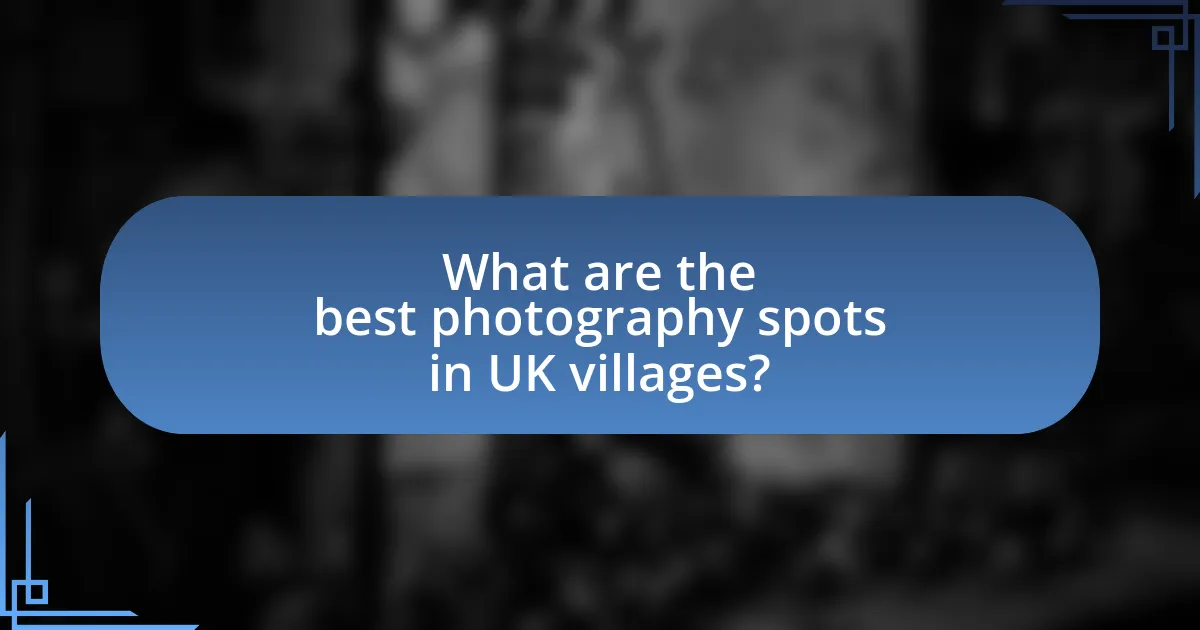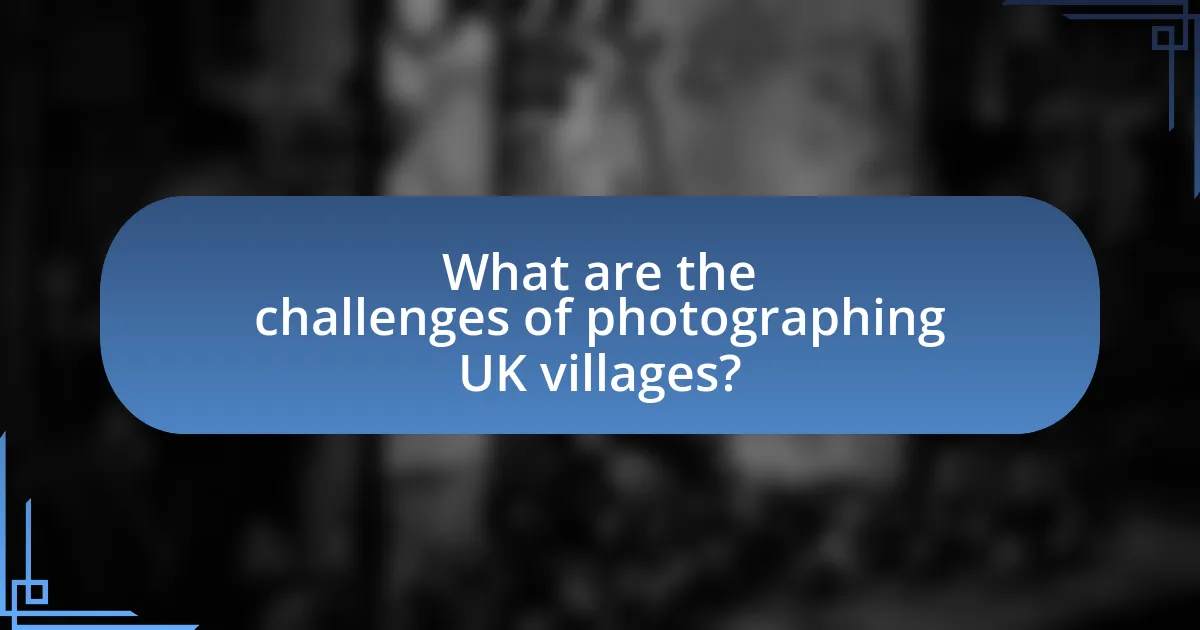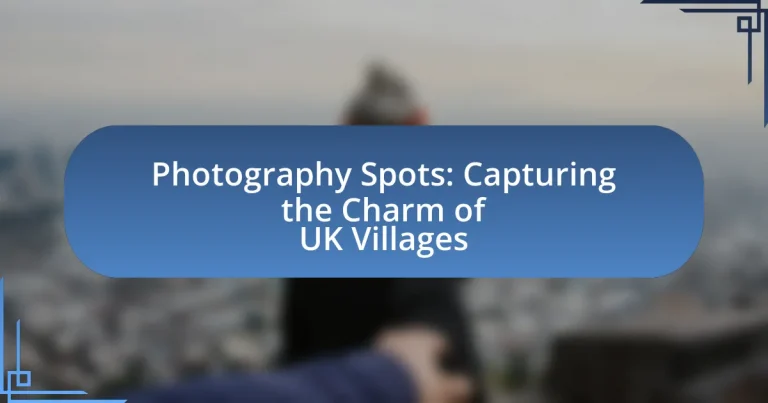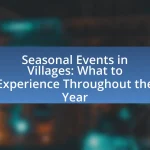The article focuses on the best photography spots in UK villages, highlighting locations such as Bibury, Castle Combe, Portmeirion, and Clovelly, known for their scenic beauty and unique architectural features. It explores how these villages offer diverse photography opportunities through their landscapes, historic buildings, and vibrant local culture, while also discussing the impact of seasonal changes on photography. Key techniques for capturing village charm, including optimal lighting, composition strategies, and engagement with local culture, are outlined, along with the challenges photographers may face, such as weather conditions and access limitations. The article emphasizes the importance of preserving the essence of rural life through photography, which can promote tourism and enhance appreciation for these picturesque communities.

What are the best photography spots in UK villages?
The best photography spots in UK villages include the picturesque village of Bibury in Gloucestershire, known for its iconic Arlington Row cottages, and the charming village of Castle Combe in Wiltshire, often referred to as the “prettiest village in England.” Additionally, the coastal village of Portmeirion in Wales offers vibrant architecture and stunning landscapes, while the quaint village of Clovelly in Devon features steep cobbled streets and breathtaking views of the Atlantic Ocean. These locations are celebrated for their unique character and scenic beauty, making them ideal for capturing the essence of rural England.
How do UK villages offer unique photography opportunities?
UK villages offer unique photography opportunities through their picturesque landscapes, historic architecture, and vibrant local culture. The diverse scenery, including rolling hills, quaint cottages, and lush gardens, provides a rich backdrop for photographers. For instance, villages like Bibury in the Cotswolds are renowned for their iconic stone buildings and scenic river views, attracting photographers seeking to capture quintessential English charm. Additionally, the seasonal changes in these villages, such as blooming flowers in spring or autumn foliage, create dynamic photographic subjects. The combination of natural beauty and cultural heritage makes UK villages a compelling choice for unique photography.
What characteristics make a village photogenic?
A village is considered photogenic when it possesses unique architectural features, scenic landscapes, and vibrant colors. Architectural elements such as quaint cottages, historical buildings, and distinctive local styles contribute to visual interest. Scenic landscapes, including rolling hills, rivers, and gardens, enhance the natural beauty of the village. Additionally, vibrant colors from flowers, painted houses, and seasonal changes create striking contrasts that attract photographers. These characteristics collectively create compelling compositions that are visually appealing and capture the essence of rural charm.
How does the time of year affect photography in villages?
The time of year significantly affects photography in villages by altering the lighting, colors, and overall atmosphere. For instance, spring brings vibrant blooms and lush greenery, enhancing the visual appeal of rural landscapes, while autumn offers rich, warm tones from changing leaves, creating a cozy ambiance. Additionally, winter can provide a serene, stark beauty with snow-covered scenes, ideal for capturing a different mood. These seasonal changes influence not only the aesthetic quality of photographs but also the types of activities and events that can be documented, such as harvest festivals in the fall or village fairs in summer.
Why is capturing the charm of UK villages important?
Capturing the charm of UK villages is important because it preserves cultural heritage and promotes tourism. The unique architecture, landscapes, and local traditions found in these villages reflect the historical and social narratives of the region. For instance, villages like Bibury and Castle Combe showcase traditional Cotswold stone cottages and picturesque settings that attract visitors, contributing significantly to the local economy. Additionally, photography serves as a medium to document and share these visual stories, fostering appreciation and awareness of rural life in the UK.
What stories do UK villages tell through photography?
UK villages tell stories of tradition, community, and natural beauty through photography. Images capture the essence of rural life, showcasing historical architecture, local festivals, and the changing seasons. For instance, photographs of thatched cottages and ancient churches reflect the architectural heritage and cultural identity of these communities. Additionally, images of village fairs and markets highlight social interactions and local customs, emphasizing the importance of community ties. The picturesque landscapes, often featuring rolling hills and lush gardens, convey the serene and idyllic nature of village life, attracting both tourists and photographers alike.
How can photography promote tourism in rural areas?
Photography can promote tourism in rural areas by showcasing their unique landscapes, culture, and heritage, which attracts potential visitors. High-quality images of picturesque villages, local festivals, and natural beauty can be shared on social media platforms, increasing visibility and interest. For instance, a study by the University of Exeter found that visually appealing content significantly influences travel decisions, with 79% of travelers stating that images inspire their travel choices. This demonstrates that effective photography can enhance the appeal of rural destinations, leading to increased tourist footfall and economic benefits for local communities.

What types of photography can be done in UK villages?
Various types of photography can be done in UK villages, including landscape, architectural, street, wildlife, and portrait photography. Landscape photography captures the natural beauty of rural settings, often featuring rolling hills, fields, and waterways. Architectural photography focuses on the unique structures and historical buildings found in villages, showcasing their design and character. Street photography documents everyday life and local culture, capturing candid moments of villagers and their activities. Wildlife photography can be pursued in rural areas, highlighting the diverse fauna that inhabits these regions. Lastly, portrait photography can be conducted in picturesque village settings, utilizing the charming backdrops to enhance the subject’s appeal. Each type of photography benefits from the distinct atmosphere and scenic views that UK villages offer.
How can landscape photography be enhanced in village settings?
Landscape photography can be enhanced in village settings by utilizing natural light during golden hours, which are shortly after sunrise and before sunset. This time provides soft, warm lighting that accentuates the textures and colors of the landscape, creating visually appealing images. Additionally, incorporating local architecture, such as cottages or historical buildings, into the composition adds context and interest, making the photographs more relatable and engaging. Research indicates that the use of leading lines, such as pathways or fences, can guide the viewer’s eye through the image, enhancing depth and perspective. Furthermore, capturing seasonal changes, like blooming flowers in spring or autumn foliage, can provide dynamic elements that enrich the landscape.
What are the best techniques for capturing village landscapes?
The best techniques for capturing village landscapes include using wide-angle lenses, shooting during golden hour, and incorporating leading lines. Wide-angle lenses allow photographers to capture expansive views of the village, emphasizing its layout and surroundings. Shooting during golden hour, which occurs shortly after sunrise or before sunset, enhances the landscape with warm, soft lighting that adds depth and richness to colors. Incorporating leading lines, such as paths or fences, guides the viewer’s eye through the image, creating a sense of depth and perspective. These techniques are widely recognized in photography for their effectiveness in showcasing the beauty and charm of village landscapes.
How does lighting influence landscape photography in villages?
Lighting significantly influences landscape photography in villages by affecting the mood, color saturation, and depth of the images captured. Natural light, particularly during the golden hour—shortly after sunrise and before sunset—creates warm tones and soft shadows, enhancing the picturesque qualities of village scenes. For instance, studies show that images taken in this lighting can appear more inviting and vibrant, which is crucial for showcasing the charm of rural settings. Additionally, the direction of light can highlight architectural features and natural landscapes, providing texture and dimension that are essential for compelling photography.
What role does architectural photography play in capturing village charm?
Architectural photography plays a crucial role in capturing village charm by highlighting the unique architectural features and historical context of village structures. This type of photography emphasizes the aesthetic qualities of buildings, such as their design, materials, and integration with the surrounding landscape, which collectively contribute to the village’s identity. For instance, the use of natural light and composition in architectural photography can enhance the visual appeal of quaint cottages, traditional pubs, and historic churches, making them more inviting and representative of the village’s character. By documenting these elements, architectural photography preserves the essence of village life and promotes cultural heritage, allowing viewers to appreciate the charm and beauty of rural settings.
Which architectural styles are commonly found in UK villages?
Common architectural styles found in UK villages include Tudor, Georgian, and Victorian. Tudor architecture is characterized by its timber-framed buildings, steeply pitched roofs, and decorative half-timbering, prevalent in villages dating back to the 15th and 16th centuries. Georgian style, prominent in the 18th century, features symmetrical designs, brick facades, and sash windows, reflecting the elegance of that era. Victorian architecture, which flourished in the 19th century, showcases a variety of styles, including Gothic Revival and Italianate, often with ornate detailing and vibrant colors. These styles contribute to the unique charm and historical significance of UK villages, making them popular subjects for photography.
How can photographers highlight unique village architecture?
Photographers can highlight unique village architecture by utilizing composition techniques that emphasize distinctive features, such as symmetry, texture, and historical context. For instance, framing buildings with natural elements like trees or pathways can draw attention to architectural details. Additionally, capturing the golden hour light enhances textures and colors, making structures appear more vibrant. Research indicates that using leading lines can guide the viewer’s eye toward focal points, effectively showcasing the unique characteristics of village architecture. This approach not only captures the aesthetic appeal but also conveys the cultural significance of the structures, as many villages in the UK have buildings that date back centuries, reflecting their historical narratives.

What are the challenges of photographing UK villages?
Photographing UK villages presents several challenges, including variable weather conditions, limited access to certain areas, and the need to capture the essence of rural life without intruding. The unpredictable weather can lead to poor lighting or rain, which affects image quality. Additionally, many villages have restricted access to private properties or sensitive areas, limiting the photographer’s ability to capture desired angles or scenes. Furthermore, portraying the authentic charm of village life requires sensitivity to local customs and the presence of residents, which can complicate candid photography. These factors collectively make photographing UK villages a nuanced endeavor that demands careful planning and adaptability.
How can weather conditions impact photography in villages?
Weather conditions significantly impact photography in villages by influencing lighting, mood, and visibility. For instance, overcast skies can create soft, diffused lighting that enhances colors and reduces harsh shadows, making it ideal for capturing the intricate details of village architecture. Conversely, bright sunlight can produce stark contrasts and deep shadows, which may detract from the overall composition. Additionally, rain can add a reflective quality to surfaces, enriching the visual narrative, while fog can create a sense of mystery and depth, often enhancing the charm of rural landscapes. Historical data shows that photographers often prefer shooting during the golden hour, shortly after sunrise or before sunset, when the light is warm and soft, further illustrating how weather conditions dictate optimal photography times.
What strategies can photographers use to adapt to changing weather?
Photographers can adapt to changing weather by utilizing flexible planning, appropriate gear, and creative techniques. Flexible planning involves monitoring weather forecasts and being prepared to adjust shooting schedules or locations based on conditions. Appropriate gear, such as weather-sealed cameras and protective covers, ensures equipment remains functional in adverse conditions. Creative techniques, like using dramatic lighting during storms or capturing reflections in puddles, can enhance the visual appeal of photographs. These strategies enable photographers to effectively capture the charm of UK villages regardless of weather changes.
How can lighting conditions be managed for optimal results?
Lighting conditions can be managed for optimal results in photography by utilizing natural light effectively and adjusting settings accordingly. Photographers should aim to shoot during the golden hour, which occurs shortly after sunrise and before sunset, as this provides soft, warm light that enhances the charm of UK villages. Additionally, using reflectors can help bounce light onto subjects, reducing harsh shadows and creating a more balanced exposure. According to a study by the American Society of Photographers, optimal lighting significantly improves image quality, making it essential for capturing the picturesque elements of rural landscapes.
What are common pitfalls to avoid when photographing villages?
Common pitfalls to avoid when photographing villages include neglecting the time of day, overlooking composition, and failing to engage with the local culture. Photographers often miss the best lighting conditions, such as golden hour, which enhances the charm of village scenes. Additionally, poor composition can lead to uninteresting images; using techniques like the rule of thirds can significantly improve visual appeal. Lastly, not interacting with locals can result in missed opportunities for authentic shots that capture the essence of village life, as local events or unique architecture may provide compelling subjects.
How can photographers ensure they capture the essence of a village?
Photographers can ensure they capture the essence of a village by immersing themselves in the local culture and environment. Engaging with residents allows photographers to understand the unique stories, traditions, and daily life that define the village. For instance, capturing candid moments during local festivals or daily routines provides authentic representations of the community. Additionally, utilizing natural light during golden hours enhances the village’s aesthetic, showcasing its architecture and landscapes in the best possible way. Research indicates that photographs taken during these times evoke emotional responses, making them more impactful. By combining cultural engagement with optimal lighting, photographers can effectively convey the true spirit of a village.
What mistakes should be avoided to enhance photo quality?
To enhance photo quality, avoid using poor lighting conditions, as they can lead to underexposed or overexposed images. Natural light, especially during golden hours, significantly improves image clarity and color vibrancy. Additionally, neglecting to stabilize the camera can result in blurry photos; using a tripod or stabilizing techniques ensures sharpness. Another mistake is failing to compose the shot effectively; applying the rule of thirds can create more engaging images. Lastly, overlooking post-processing can diminish the final quality; editing software can correct exposure, contrast, and color balance, enhancing the overall appearance of the photograph.
What tips can help photographers capture the charm of UK villages effectively?
To effectively capture the charm of UK villages, photographers should focus on the golden hour for lighting, emphasizing natural light during sunrise or sunset. This time enhances the warmth and colors of the village scenery, making buildings and landscapes appear more inviting. Additionally, incorporating local elements such as traditional architecture, unique signage, and community life can add authenticity to the photographs. Research indicates that images featuring human interaction or local culture resonate more with viewers, as they evoke a sense of place and connection. Lastly, using leading lines and framing techniques can guide the viewer’s eye through the composition, highlighting the village’s character and charm.
How can planning and research improve photography outcomes?
Planning and research significantly enhance photography outcomes by ensuring that photographers are well-prepared for their shoots. By identifying optimal locations, understanding lighting conditions, and anticipating weather patterns, photographers can capture more compelling images. For instance, a study by the Royal Photographic Society highlights that pre-visualization of scenes leads to a 30% increase in the quality of photographs taken in natural settings. This preparation allows photographers to select the best times for shooting, such as golden hour, which is crucial for achieving aesthetically pleasing results. Additionally, researching the history and culture of UK villages can inspire creative compositions and storytelling elements in photography, further enriching the visual narrative.
What equipment is essential for village photography?
Essential equipment for village photography includes a DSLR or mirrorless camera, a versatile lens (such as a 24-70mm), a tripod, and a polarizing filter. A DSLR or mirrorless camera provides high image quality and flexibility in various lighting conditions, which is crucial for capturing the unique charm of villages. A versatile lens allows for both wide-angle shots of landscapes and close-ups of architectural details. A tripod stabilizes the camera for long exposure shots, especially in low light, while a polarizing filter enhances colors and reduces glare, making the images more vibrant. These tools collectively enable photographers to effectively capture the essence of village life and scenery.


